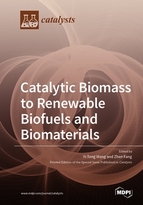Catalytic Biomass to Renewable Biofuels and Biomaterials
A special issue of Catalysts (ISSN 2073-4344). This special issue belongs to the section "Biomass Catalysis".
Deadline for manuscript submissions: closed (31 December 2019) | Viewed by 47613
Special Issue Editors
Interests: nanocatalysts; conversion of biomass; thermo-chemical conversion; biomaterials
Special Issues, Collections and Topics in MDPI journals
Special Issue Information
Dear Colleagues,
Renewable, clean and environmentally friendly biofuels and biomaterials applications are in line with the healthy development of the world's energy and materials in the future. Biomass as the only renewable carbon source on Earth has been proposed as an ideal alternative to fossil resources and can be catalytically conversed to valuable products, such as hydrolysis of lignocellulosic wastes, synthesis of biodiesel and bioethanol, thermal conversions of biomass and organic wastes and so on. This special issue receives original research papers focused on biomass catalytic conversion to renewable biofuels and biomaterials. Submissions are welcome especially (but not exclusively) in the following areas:
- Catalysis;
- Bio-catalysis;
- Biodiesel;
- Nano-cellulose;
- Chemicals;
- Gaseous and liquid biofuels;
- Biogas;
- Ethanol;
- Butanol;
- Green chemistry;
Prof. Zhen Fang
Dr. Yi-Tong Wang
Guest Editors
Manuscript Submission Information
Manuscripts should be submitted online at www.mdpi.com by registering and logging in to this website. Once you are registered, click here to go to the submission form. Manuscripts can be submitted until the deadline. All submissions that pass pre-check are peer-reviewed. Accepted papers will be published continuously in the journal (as soon as accepted) and will be listed together on the special issue website. Research articles, review articles as well as short communications are invited. For planned papers, a title and short abstract (about 100 words) can be sent to the Editorial Office for announcement on this website.
Submitted manuscripts should not have been published previously, nor be under consideration for publication elsewhere (except conference proceedings papers). All manuscripts are thoroughly refereed through a single-blind peer-review process. A guide for authors and other relevant information for submission of manuscripts is available on the Instructions for Authors page. Catalysts is an international peer-reviewed open access monthly journal published by MDPI.
Please visit the Instructions for Authors page before submitting a manuscript. The Article Processing Charge (APC) for publication in this open access journal is 2700 CHF (Swiss Francs). Submitted papers should be well formatted and use good English. Authors may use MDPI's English editing service prior to publication or during author revisions.
Keywords
- Hydrolysis and pyrolysis of biomass wastes
- Biofuels production
- Biomass conversion
- Biomaterials synthesis
- Novel catalysts synthesis for biomass conversion







